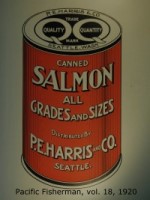
The P.E. Harris & Co. salmon cannery in False Pass was originally built in Morzhovoi Bay by Sockeye Salmon Co., a picture of which can be seen here. The quotation below shows that the cannery was moved from Morzhovoi Bay to the False Pass site by Sockeye Salmon Co. and leased and then sold to P.E. Harris. This move apparently happened after the salmon season in June because the Sockeye Salmon cannery packed 24,155 cases in 1919 in Morzhovoi Bay.4 The first year of canning in False Pass began when P.E. Harris leased the cannery in 1920 and 51,659 cases were canned by PEH for the Sockeye Salmon Co.5
"The Sockeye Salmon Co. built and operated in the same year <1917> a new cannery on Morzhovia Bay, a few miles from the strait, and on the Alaska Peninsula. In 1920 the latter was moved to the Unimak Island side of the strait...... Three changes occurred in the ownership of canneries in Alaska in 1920. .... the Sockeye Salmon Co. leased its cannery on Isanotski Strait to P. E. Harris & Co."1
The buildings were moved from Morzhovoi Bay in sections by using the power provided by coal-fired steam-driven winches on the pile drivers. The buildings were skidded onto flat scows and towed to False Pass by tenders. The winches pulled the buildings ashore by using "dead man" anchors on shore and a complex setup of pulleys and cables for leverage. The pile drivers were versatile construction rigs that also drove the salmon traps and all the piling for the docks and foundation of the canning buildings which were built over water. The main bunkhouses were built over or near fresh water streams which served as a sanitary disposal system.2
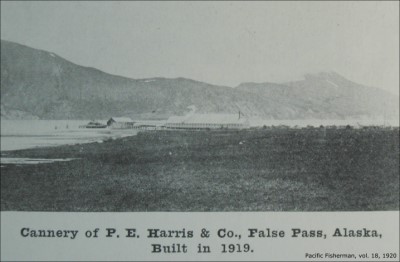
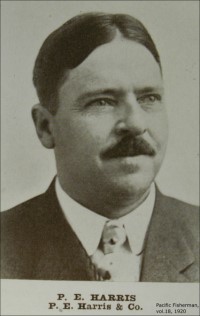
Prince Edward Harris was already a salmon broker in Seattle when he bought the cannery, traps and vessels from Sockeye Salmon Co. in nearby Morzhovoi Bay. He had founded his own company, P.E. Harris Co., in 1912. He bought several canneries in S.E. Alaska, including Hawk Inlet, but the False Pass cannery was his consistent high producer of excellent quality red (sockeye) salmon. 2
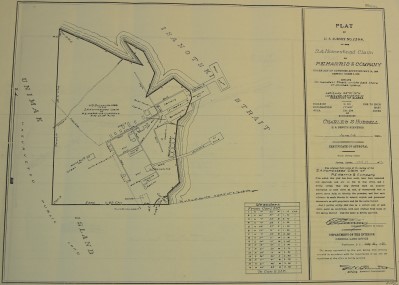
The 1926 survey plat for the cannery shows that the basic layout of the cannery has not substantially changed until this day. The entire complex is connected by boardwalks. There were no roads at the cannery nor in the community. Separate quarters were provided for the Chinese and Native American workers. The machinists and other tradesmen had their own bunkhouse and messhall. There was a vegetable garden and meat was kept cool and protected from bears by being built over a pond created by a spring near the bunkhouse. Coal was used to fire the cannery boilers and process the salmon, heat the buildings and cook the food. The coal was brought in on flat scows that were tied up to the Coal Slip. The coal was then taken by wheel barrow to the coal bin shown on the plat. Communications with the outside world and other canneries was by "wireless" (radio), Morse Code.
Click on plat to see larger version
![]()
Salmon from traps supplied most of the fish to the P.E. Harris cannery for many years until Alaska became a state in 1959 and the traps were outlawed. The text for the picture at the right reads:
"The P.E. Harris & Co.'s tender Amelie is bringing in a catch of 45,000 salmon taken about July 6 from three traps in Ikatan Bay: 15,000 on the scow and 30,000 in the boat, which had a deckload in addition to a full hold, and was down to within inches of the hawse pipes. Such loads, running about 75 per cent Reds, were not uncommon in that locality during the height of the run."3Because the traps were located only in the Ikatan Bay area, and because other salmon species were targeted in other areas that could be caught only with boats, the cannery also bought fish from independent salmon seiners and gillnetters.2
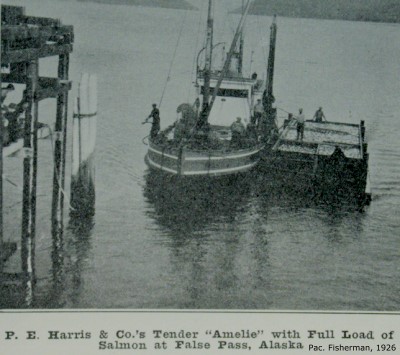
A film about the P.E. Harris & Co. cannery in False Pass and salmon trap fishing was made by Father Bernard Hubbard in 1936. It is called "Alaska's Silver Millions" and can be viewed here.
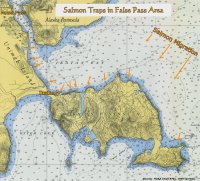
Salmon traps in the False Pass area were located in Ikatan Bay and along the Ikatan Peninsula. During the trapping years, some trap locations were found to be poor producers, so they were not used. Some of these traps belonged to the P.E. Harris cannery in False Pass and some to Pacific American Fisheries (PAF) who had a cannery in Ikatan. After the Ikatan cannery closed in about 1935, the PAF fish were taken to King Cove for processing. 2 Click on map for larger version.
The cannery boat ways was built about half a mile north of the main cannery buildings. The ways had a coal-fired steam donkey that pulled the heavy vessels out of the water onto dry land. The vessels were loaded onto a steel-wheeled cradle and hauled up a steel track. Then, each vessel was pulled laterally onto the side tracks on wooden shoes lubricated with axel grease. In this way all the vessels could be safely stored on dry land until the next season. False Pass did not get a boat harbor until 2009, so a boat ways was essential to store the pile drivers, scows, tenders and company fishing boats over the winter.
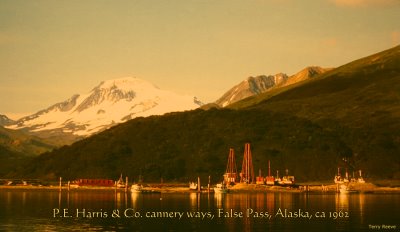
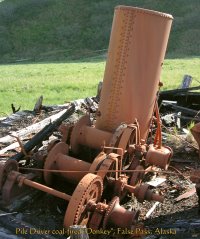
This is the pile driver steam donkey after the driver structure was burned. The tall cylinder is the coal-fired boiler that made the steam. Click on picture for a larger version.
The boat ways in 1962. The two pile drivers (puller and driver) are on the left, next are the two salmon tenders, the Izembek & Glazenap, and then several salmon seine boats. The pile drivers never came back down the ways because the salmon traps had been outlawed. They were burned for safety reasons a number of years later.
Click on picture for a larger version.
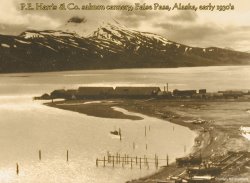
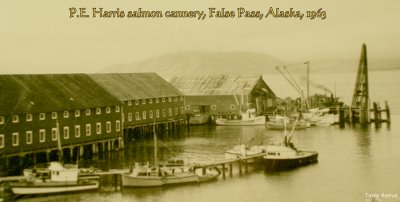
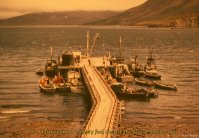
This early cannery photo shows that the creek that now enters The Pass south of the cannery, entered on the north side. The fuel tanks were located where the fuel house is now. The foreground shows the boat ways. Click on photo for larger version.
This is the cannery in about 1963. The original fish house is shown in the center. It was later taken out by ice in The Pass. The pile driver is tied up to the finger pier and is fired up. In the foreground is shown the Coal Slip, a favorite place where local salmon boats tied up because it was close to boat deck height. The large cannery two-storey buildings housed the carpenter shop, the tin storage loft, the can cooling area with the can forming machinery above. Click on photo for larger version.
The fuel dock is where most of the fishing boats tied up and received fuel. The orange/grey boats are company gillnetters from Port Moller down for the June south side fishery. Click on photo for larger version.
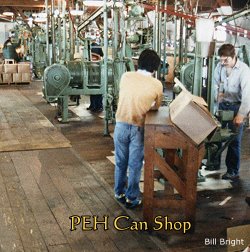
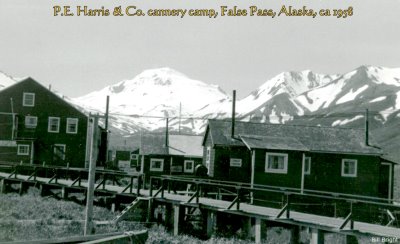
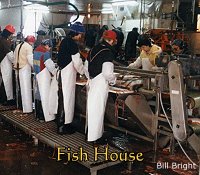
The can shop is where the flat cans without top or bottom were reformed and had the bottom put on. It was located on the second floor where it was warm and dry.
The cannery camp was connected by boardwalks. The two-storey building housed the store, the office, the superintendent's quarters, the white messhall and bunkhouse for machinists. It burned in 1958. The cabin on the right is the Foreman's place and just beyond that is the Winterman's cabin.
The fish house is where the salmon entered the processing line. First the fish were headed and gutted by the Iron Chink, then slimed here.
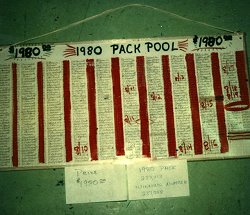
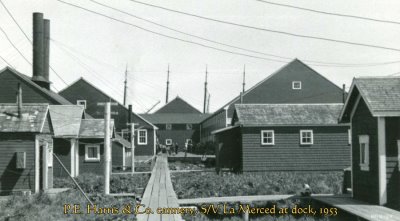
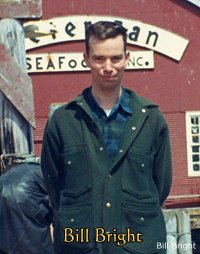
The Pack Pool was created each year by the fish cook and he posted the list next to the retorts. The 1980 prize was $1,980 and was the last pack pool in the 60 year history of the cannery. The winning guess was 237,058 for the actual pack of 237,113 cases.
Cannery view, looking NE with Nick Bez's La Merced, a converted sailing vessel, tied up at the main dock in the background showing its tall masts. The main canning room was the large building on the left with the visible windows. The tall smoke stacks of the boiler house are on the left. Originally the boilers burned coal, then they were converted to burn "bunker oil" a thick black fuel. Later, these boilers were abandoned and a new smaller diesel-fired boiler was installed near the retorts. The large building on the right housed the carpenter shop below and the can loft above. Cabins on the left and right of the boardwalk housed the Winterman, the machinists and the Cannery Foreman. Click on photo for larger version.
Bill Bright was the last cannery plant manager. Bill started out on the Cape Douglas in 1950, anchored off Morzhovoi village. Then, he worked on the P.E. Harris tender Izembek. In 1953 he became the cannery bookkeeper. He was promoted to cannery superintendent in 1976 and retired in 2000. Bill passed away in Seattle on July 30, 2007. Hear a 2004 interview with Bill here.
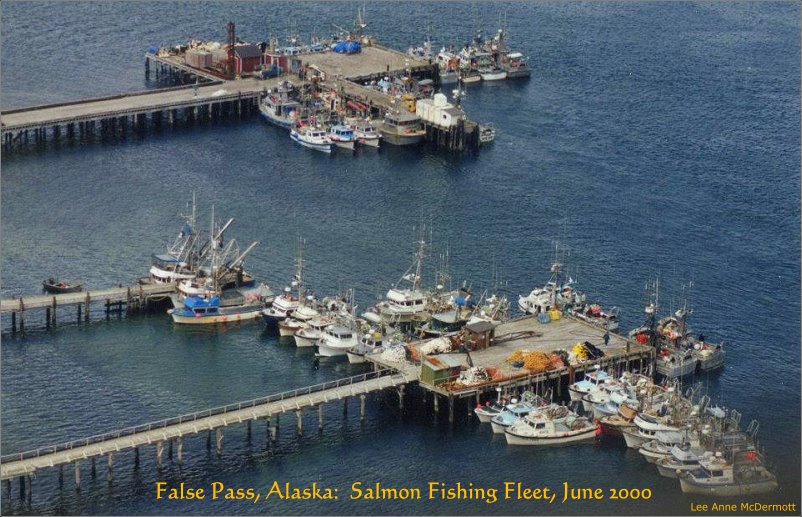
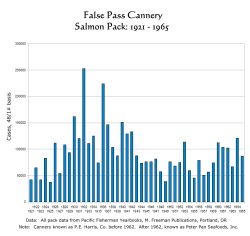
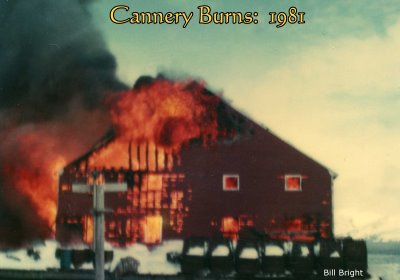
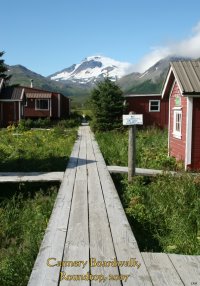
The historical canned salmon pack at False Pass to 1965 has shown a great deal of variation. During that period, the highest pack was over 250,000 cases in 1932. Later on, the cannery actually stopped processing due to low salmon runs for three years, 1974-76. The last year of processing was 1980. Click on image to see larger version.
The False Pass cannery buildings burned to the ground in 1981. The fire reportedly started in the generator house that was attached to the main canning room. There were no adequate means for fighting the fire so it simply had to burn itself out. Although all the main canning buildings were burned, the shore support buildings where the bunkhouses, messhall, store, hardware and fuel facility etc. were located were untouched. After 1981, these shore buildings were used as a "Fish Camp" that helped support the fishing fleet. The fish camp was terminated in 2004.
The old cannery shore buildings, docks and boardwalks still exist and are minimally maintained. The fuel facility (as of December, 2010) still sells diesel, stove oil and gasoline to the fishing fleet and community. Click on photo to see larger version.
Audio Interviews about the Old Cannery and Fishing:
1) Bill Bright interview; the last False Pass salmon cannery plant manager. (2004, MP3 audio file, 1 hour 43 minutes long)
2) John Petrinovich interview: purse seine and gillnet salmon fisherman since 1950. (2001, MP3 audio file, 1 hour 35 minutes long)
Historical Time Line for the P.E. Harris/Peter Pan Seafoods, False Pass Cannery:
1917: Cannery buildings that are to become P. E. Harris & Co, built at Sockeye Salmon Company in Morzhovoi Bay.
1918: Sockeye Salmon Company cans salmon in Morzhovoi Bay.
1919: Sockeye Salmon Company cans salmon first part of season, moves all buildings & machinery to False Pass that summer.
1920: Mr. Prince Edward Harris leases Sockey Salmon Co. cannery buildings in False Pass & cans salmon for Sockeye Salmon Co.
1921: P.E. Harris Co., first salmon pack in False Pass under PEH ownership; second salmon pack in False Pass.
1925: PEH had 6 salmon traps; #3,5,8 & 10 on Ikatan Peninsula and one at Settlement Point & one at Pavlof Bay.
1930's: Cannery boilers switch from coal to bunker oil.
1950: Five "Land" Boat limit Purse Seiners, 6 local Beach Seiners + ~2 Puget Sound Seiners sold fish to company.
1942-45: Cannery operates during WWII to supply needed salmon.
1947: PEH buys WWII vessels to convert to salmon tenders, such as Jim B, Kathy B, etc., and landing craft such as Izembek & Glazenap.
1950: Borge Larsen starts work with PEH as salmon trap watchman.
1951: Borge becomes winter watchman with uncle Chris Larsen.
1950: Nick Bez buys P.E. Harris & Co., keeps P.E. Harris company name.
1951: Nick Bez buys Cape Douglas that was processing salmon off Morzhovoi Village and ends further processing on Cape Douglas.
1953: Nick Bez's La Merced, a converted sailing vessel, ends processing in this area by tying up and working at PEH dock.
1954-55: Bill Lilly is Cannery Superintendent.
1956-57: Carl Paulus is Cannery Superintendent.
1957: Pile Drivers put on boat ways for last time, never to be used again.
1958: Store/Office/Bunkhouse building burns after just a few years in operation. Store & office moved to part of Filipino Bunkhouse.
1958: Don Rawlinson becomes Cannery Superintendent.
1959: Fish Traps outlawed by U.S. Dept. of the Interior, March 7, 1959. See link to document here.
1959: Gillnetting started on south side Unimak June fishery, with 4 boats.
1960: Port Moller gillnetters fish south side Unimak; 30 boats, 1/2 PEH, 1/2 PAF
1962: Cannery Boilers switch from Bunker Oil to Diesel.
1962: P.E. Harris & Co. name changed to Peter Pan Seafoods, Inc. by marketing department, using Peter Pan brand owned by PEH.
1965: Salmon Limited Entry system under development by State of Alaska.
1965: PPSF buys western operations of Pacific American Fisheries (PAF), including King Cove & Port Moller; PAF ceases to exist.
1968: Cannery Boat Ways w/steam donkey operates for last time.
1968: Standard Oil transfers ownership of oil facility to PPSF.
1970: Fiberglass fishing boats begin to replace wooden boats in local fishing fleet.
1973: Salmon Limited Entry system becomes law & salmon permits issued for seining, drift gillnetting and setnetting.
1973: PPSF sells Company boats to salmon permit holders thereby ending ownership of fishing boats by company.
1974-75-76: PPSF-FP does not operate due to poor salmon runs.
1975: Bristol Bay Native Corporation (BBNC) buys PPSF.
1976: Bill Bright becomes Cannery Superintendent (previously, the bookkeeper) when cannery resumes operation.
1978: BBNC sells PPSF to Nichiro Corporation of Japan, keeps Peter Pan name.
1981: False Pass Cannery main buildings burn, but shore buildings survive.
1981: PPSF-False Pass facility becomes "Fish Camp", using shore buildings, store & hardware to service salmon fleet.
2000: Bill Bright retires as PPSF-FP Superintendent (Plant Manager).
2004: Peter Pan Seafoods-False Pass facility closes grocery store & hardware, keeps fuel sales going with winterman in charge.
2007: Bill Bright, retired cannery superintendent, passes away in Seattle on July 30th.2
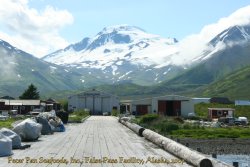
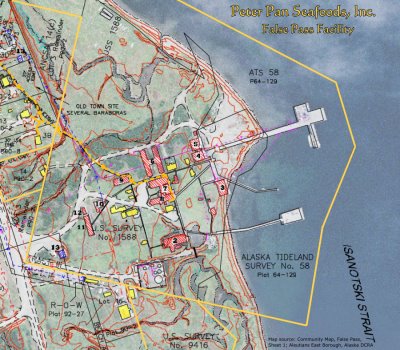
Click on map & photos to see larger versions
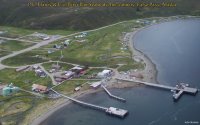
The Peter Pan-False Pass Facility in 2007, looking down the main dock towards the shore buildings. Directly ahead is the old hardware/stockroom that is now used as the office for the caretaker. The generator building, fishermen's lockers and propane shed are to the right.
Seen from the air in 2001, the old cannery shore buildings are still much the same today. The docks are still in use by company boats but are no longer used by the coastal freighters. Public services have been moved to the City of False Pass.
References:
1) Report of the United States Commissioner of Fisheries to Secretary of Commerce, USGPO, 1921., pg. 49
2) Bill Bright, personal communication.
3) Pacific Fisherman, vol. 24, 1926
4) Pacific Fisherman Yearbook, vol. 18, 1920
5) Pacific Fisherman Yearbook, vol. 19, 1921
